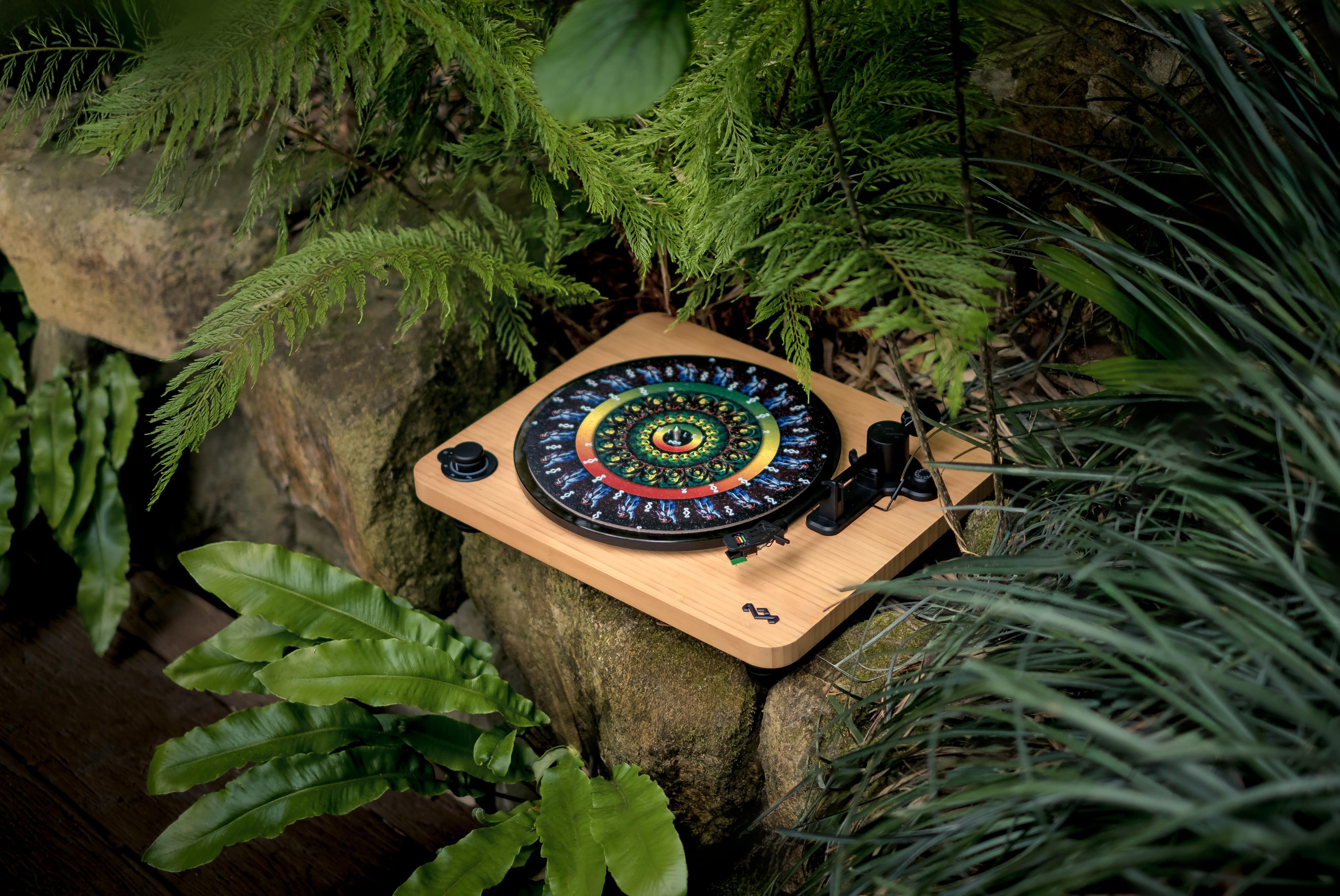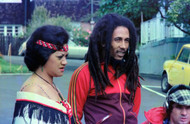Bob Marley: Biography, Albums, Facts & More
Posted by House of Marley on May 21st 2024
Bob Marley isn’t just one of the most influential figures in music. He’s a cultural icon.
That’s because Marley was so much more than a musician. He was a songwriter, artist, and activist, uplifting generations with his message of One Love. He’s also the inspiration behind House of Marley’s series of sustainable speakers, turntables, and headphones.
Even if you don’t know his songs, you know his face and his legacy. And now, through our brief Bob Marley biography, you’ll know his story.
Early Life and Background
Like so many who go on to change the world, Marley came from humble beginnings. Those origins are where our story starts.
Birth and Family Background
Robert Nesta Marley was born in Nine Miles, Jamaica, on February 6, 1945, to Cedella Malcolm and Norval Sinclair Marley.[1]
Although he briefly lived with his father, Norval, in Kingston for 18 months, Marley spent most of his childhood in the rural community of his birth with his mother, Cedella Malcolm.[2]
Early Musical Influences and Trench Town
As a teen in the late 1950s, Marley moved to a neighborhood known as Trench Town, just outside of the Jamaican capital. Named for the sewage trench over which it was built, Trench Town had a reputation for being a rough-and-tumble place—and one where Marley had to learn to fight for himself.
Despite the chaos and poverty, it was in Trench Town that Marley’s love of music flourished. A new genre called “ska” was taking over the Jamaican music industry, and Marley found himself drawn in. This local fusion of soul and R&B, coupled with the oral storytelling history of his upbringing in Nine Miles, would have a profound impact on Marley’s music.[3]
The Rise of The Wailers
By 16, Bob Marley had already devoted himself to music, recording a few songs as a solo artist to little fanfare. But it wasn’t until a little later that Marley found success with his band The Wailers.
Formation and Early Success
In 1963, Marley, with friends Neville “Bunny” O’Riley Livingston and Peter McIntosh (Peter Tosh), formed a band. The group went through several name changes, including:
- The Teenagers
- The Wailing Rudeboys
- The Wailing Wailers
- The Wailers
It was under this last name that the band’s first single “Simmer Down” topped the Jamaican charts in 1964.
Despite some lineup instability, the group’s popularity grew at home. However, finances were always an issue, and in 1966, Marley married Rita Anderson and moved to Wilmington, Delaware, pausing the band to work odd jobs in the US and be with his mother. Rita Anderson, who became Rita Marley after marrying Bob, was not only his wife but also a collaborator in his music career, providing backing vocals on many of his tracks and helping to preserve his legacy after his passing.
The Transition to Reggae
In their early years, The Wailers were playing the music of the time: Jamaican ska and R&B. But when Marley returned to Jamaica, the times were changing—and so was popular music. A new style of Jamaican music called “reggae” was on the rise.
Reggae took the up-tempo, offbeat rhythm of ska (and slower rocksteady) and slowed it down even further.
By 1970, the Wailers had partnered with Lee “Scratch” Perry, a guiding force in dub and reggae music. Together with Perry’s team of musicians, The Wailers laid the groundwork for the sound of roots reggae—a sound that Bob Marley made famous around the world.
International Stardom and Iconic Albums
While Marley and his band enjoyed growing success with a handful of albums in Jamaica, it wasn’t until the early 70s that The Wailers became a worldwide force. Once they reached the mainstream, however, there was no stopping the reggae movement from going global.
Collaboration with Island Records
On a trip to London in 1972, Marley landed The Wailers a big-time album deal with Island Records (after their previous label, CBS Records, abandoned them).[1] The band’s deal with Island Records was unheard of at the time; the group was advanced £4,000 to make an album.
Their first album with Island, Catch a Fire, saw The Wailers tour the US opening for acts like Bruce Springsteen and Sly and the Family Stone. The record itself may not have been a smash, but it was only the beginning.
Groundbreaking Albums and Hits
Through the years, Bob Marley and his band produced some standout records with Island, such as:
- Burnin’ – On Burnin’, Marley and his crew hit their stride. This record has the mega-hits “Get Up, Stand Up” and “I Shot the Sheriff,” as well as some other powerful songs.
- Natty Dread – This was the first album to be released under the Bob Marley and the Wailers moniker, and it features the iconic track “No Woman, No Cry.” The tour for Natty Dread also spawned a fourth record, Bob Marley and the Wailers Live!—a musical tour de force that’ll make anyone a fan.
- Exodus – Released in 1977, Exodus was Marley’s ninth studio record and arguably his most popular. Well-known tracks include “Jamming,” “Three Little Birds,” and “One Love/People Get Ready.”
Rastaman Vibration – Another Island Records classic, this album features the poignant anthem “War,” along with a handful of excellent songs that feel at home on any reggae music playlist.
There are also must-listen hits from across Marley’s career that don’t feature on these albums. Crank up your speakers and give these tracks a spin:
- Could You Be Loved
- Buffalo Soldier
- Redemption Song
- Is This Love
- Sun is Shining
- Smile Jamaica
- Punky Reggae Party
To date, Marley’s records have sold more than 75 million copies, gracing turntables around the globe.[1]
Political Activism and Rastafari
If Marley had stuck only to music, he still would have been one of the most influential figures of our time. However, his contributions to the world went beyond the rhythm and melodies of reggae.
Marley’s Rastafarian Beliefs
Bob Marley didn’t invent Rastafari, but he certainly popularized it. Developed in the 1930s in Jamaica, Rastafari is a religion, a political movement, and a way of life.[2] It’s a combination of Protestantism, mysticism, and political consciousness that promotes belief in a single God known as Jah.
Marley’s return to Jamaica after working in Delaware saw him formally convert to Rastafari, wearing his hair in dreadlocks and promoting the use of the holy herb, marijuana (or “ganja”).
Throughout his musical career, Marley shared the Rastafarian beliefs with the world, though he converted to Ethiopian Orthodox Christianity before his death.
Political Influence and Advocacy
Marley was also a pro-peace, pro-African advocate who made politics a central part of his music. Listen to some of his songs, and you’ll hear the message loud and clear: “Better to die fighting for freedom than to be a prisoner all the days of your life.”
A revolutionary for his entire career, Marley’s fight against colonialism and racism will always be remembered—particularly in Zimbabwe, where the group performed on the day that former British colony Rhodesia was renamed.[3]
The Battle with Cancer and His Final Days
Like all good stories, this one also has an end. However, the final years of Marley’s career were just as bright as the first ones, filled with worldwide tours and successful albums.
Diagnosis and Treatment
In 1977, Marley was diagnosed with skin cancer on his big toe. Despite this news, Marley continued touring and recording, playing to bigger and bigger crowds.
Unfortunately, during that time, the cancer spread to his liver, lungs and brain. Two days after Marley received this news, he played his final show on September 23, 1980, in Pittsburgh.
Although he received treatment for his illness, Marley eventually passed away on May 11, 1981, surrounded by loved ones in a hospital in Miami.
Legacy and Posthumous Recognition
Of course, the story doesn’t truly end there. Since his passing, Bob Marley has continued to change the world through his activism, his children, and his music.
Some of his biggest accomplishments happened years after his death; Marley was inducted into the Rock and Roll Hall of Fame in 1994 and received the Grammy Lifetime Achievement Award in 2001.[4]
Marley’s 11 kids also carry on his legacy; they are:
- Sharon Marley
- Cedella Marley
- David “Ziggy” Marley
- Stephen Marley
- Robert Marley
- Rohan Marley
- Karen Marley
- Stephanie Marley
- Julian Marley
- Ky-Mani Marley
- Damian Marley
Between the songs on the radio, the countless reggae cover bands, and the presence of Rastafari around the world, it’s clear that Bob Marley’s influence has—and always will—have an impact.

Bob Marley’s Enduring Connection with House of Marley
At House of Marley, we, too, carry on Bob’s legacy, melding a love of music with respect for the planet. All our portable speakers, turntables, and headphones are made from eco-conscious materials that reflect a love for the environment and for every listener.
And sustainable materials are only the beginning of our thoughtful approach.
House of Marley’s Commitment to Upholding Marley’s Legacy
We uphold the legacy of Bob Marley through several initiatives.
Our Project Marley Global Giving initiative has helped us care for the environment that supports us all. For example, since 2017, House of Marley has contributed to the planting of over 340,000 trees through One Tree Planted.
In 2023, meanwhile, we partnered with the Surfrider Foundation to protect our oceans and waterways. These are just some of the ways we’re making a difference.
Bob Marley may not have been around for the creation of House of Marley, but we’d like to think he’d be proud of our accomplishments. We certainly are.
Sources:
Biography. Bob Marley. https://www.biography.com/musicians/bob-marley
https://www.bobmarley.com/history/Encyclopedia Britannica. Rastafari. https://www.britannica.com/topic/Rastafari













